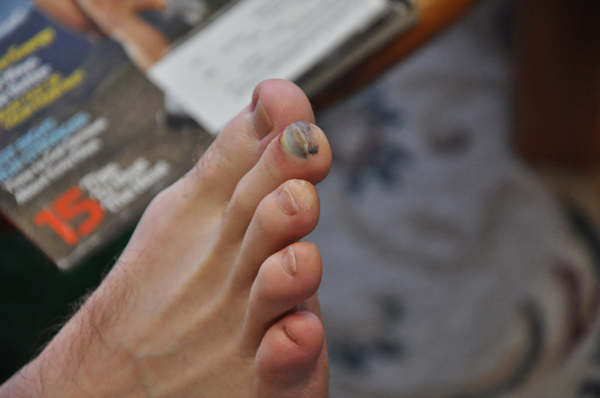NYC Marathon Special: What's Runner's Toe?

After I ran the Staten Island Half-Marathon, one of my toes looked as if I had smashed it with a hammer. Seriously. Look at that photo.
The black wreckage that is the second toe on my right foot is known as "runner's toe," and it's one of the more common injuries that distance runners suffer. After miles and miles of mashing their toes into the front of their shoes, blood pools under the toenail. While it sounds gross, it's usually not a serious condition. Podiatrists whose business picks up around marathon season expect to see plenty of concerned runners in their examination rooms.
"People get a little nervous when anything on their body turns black," said Ayne Furman, a sports medicine podiatrist in Alexandria, Va. "Most of the time, if it's not painful and you're in good health, it's not a concern."
Bloody badge of honor
Poll any group of serious distance runners those with several years spent running more than 30 miles (48 kilometers) per week and you'll most likely find someone with gnarly toes. The number of runners that suffer from black toenails hasn't garnered much scientific research since 1979, when a study of New York City Marathon runners pegged the condition as subungual hematoma the medical term for runner's toe at 2.5 percent. This rate is still cited in scientific journals today.
The cause of the condition is straightforward. When runners trot, a tight toe-box mashes toes against the front of the shoe. If runners overdo it, especially running downhill, the nail's plate will rip away from the nail bed; this is what causes the bleeding. Other issues, such as heavy pronation, having one toe that's longer than the others or a toe that's hammered or bent will exacerbate the problem.
Although weekend warriors can probably handle 6.2 miles (10 km) with no sweat, at 10 to 15 miles (16 to 24 km) the muscles that support the foot start to fatigue, allowing the foot to collapse and extend over the course of a long run, Furman said. This jams the toes even more.
Get the world’s most fascinating discoveries delivered straight to your inbox.
Room to breathe
Feet will swell on a hot race day, so buying running shoes that fit properly is essential for avoiding black toenails, said Furman.
In fact, feet will swell throughout a normal day, so runners should try on running shoes in the evening while wearing their running socks, said Tina Klein, spokesperson for the Atlanta Track Club. As a rule of thumb, runners should wear running shoes that are a full size larger than their regular shoes. Shoes that are too small almost always lead to runner's toe.
"90 percent of the time, that's the issue," Klein told Life's Little Mysteries.
Stop signs
A black toenail will most likely fall off after a few months. Don't worry; a replacement nail will most likely have formed during that time to take its place. Before that happens, however, podiatrists caution that there are a few warning signs that something is seriously wrong.
Any discomfort or loss of feeling in the toe, or any redness around the cuticle should be examined by a doctor.
Fluid pooling under the nail could cause uncomfortable pressure a pressure that many home remedies suggest burning a hole in the nail with a red-hot safety pin to let the fluid escape. This is a bad idea, said Stephen Pribut, a sports podiatrist based in Washington D.C., because the scalding safety pin could scar the tissue under the nail. Except for exceptional circumstances, this dangerous technique isn't necessary.
"A healthy person can take some time off and soak, but if there's pain a day or two later, they should see a doctor," said Karen Langone, a sports medicine podiatrist in Southampton, N. Y.
Thankfully, the only thing that hurts on me today is my eyes from looking at my pitiful toe.
Brett Israel is a staff writer for OurAmazingPlanet, a sister site to Life's Little Mysteries.
Got a question? Email it to Life's Little Mysteries and we'll try to answer it. Because of the high volume of questions we receive each day, we unfortunately can't reply individually, but we will publish answers to the most intriguing questions, so check back soon.


